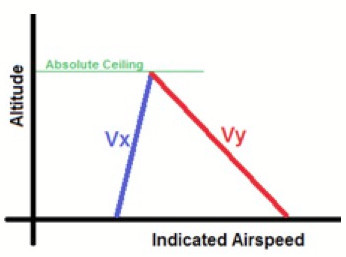I have been doing some reading on this, wondering if one can improve the time to a given altitude by varying the indicated airspeed during the climb.
There is a fair bit of stuff online about it and it appears that Vy expressed as TAS increases with altitude. But Vy expressed as IAS either stays almost the same or even reduces.
On top of that is the weight loss due to fuel getting burnt.
I am not interested in Vx because it is relevant only to obstacle avoidance, and delivers poor engine cooling.
Actually Vy delivers poor engine cooling too but this ceases to be an issue once above about 10000ft (TB20).
The normal way of looking at it is to say Vy decreases with altitude, and at absolute ceiling Vy = Vx = the only indicated airspeed at which the plane would climb the last foot.
Silvaire wrote:
The normal way of looking at it is to say Vy decreases with altitude, and at absolute ceiling Vy = Vx = the only indicated airspeed at which the plane would climb the last foot.
Sounds reasonable, but what if Vx also changes? I don’t see why it should, but.
IIRC Vx increases a little and they meet in the middle.

The numbers are in my POH (Cessna 172S)
Vy=74KIAS at sea level
Vy=72KIAS at 12000ft
While not a direct answer to the original question, here’s a Master’s thesis addressing the question of “most efficient” climbing under practical considerations.
To the original question is simpler, as it’s a local optimisation problem as opposed to a global optimisation problem. To climb to a given altitude as fast as possible, you need to fly the maximum V_y as each time, which depends on the current density altitude and weight (as already mentioned). IIRC, as a rule of thumb, V_y decreases about 1% per 1000’ of density altitude (and V_x increases about 0.5% per 1000’ of density altitude). Both decrease by about 1 kias with 100 lbs weight loss.
I came across the same topic when flying solo (i.e., light aircraft) in a high DA environment (Arizona). I noticed that at the POH V_y (i.e., sea level, standard atmosphere, max gross), the climb was sluggish, and I obtained an optimal climb rate at about 7-8 kias less in my tests. I practically never fly book V_y but usually 3-8 kias less. The best value is easily found with a light grip on the stick. ;-)
Zorg wrote:
As a rule of thumb, V_y decreases about 1% per 1000’ of density altitude (and V_x increases about 0.5% per 1000’ of density altitude).
That has to be true airspeed, not indicated airspeed.
This is one of the fun things to do with experimental aircraft  And should be done for several airspeeds.
And should be done for several airspeeds.
LeSving wrote:
That has to be true airspeed, not indicated airspeed.
If true airspeed decreases with increasing altitude, then certainly indicated airspeed will decrease too!
Vy is related to TAS as it is a function of the power available and power required curves, which in turn are derived from the thrust and drag curves transformed by TAS.
Vx is related to IAS and the thrust and drag curves, and is quite high up the back side of the drag curve with propeller aircraft. With altitude, obviously, a relative constant IAS will result in increasing TAS using the 2%/1,000’ rule of thumb. I wasn’t aware of a rule of thumb for increasing Vx IAS with altitude, although a normally aspirated engine will suffer a loss of thrust, and propeller will also start to lose thrust efficiency with altitude as compressibility sets in, so you would need to move down the drag curve to achieve the max differential of Thrust minus Drag, ie increase IAS.
Vy for propeller is close to Vmd, which in turn is close to Vx for turbofans/jets.